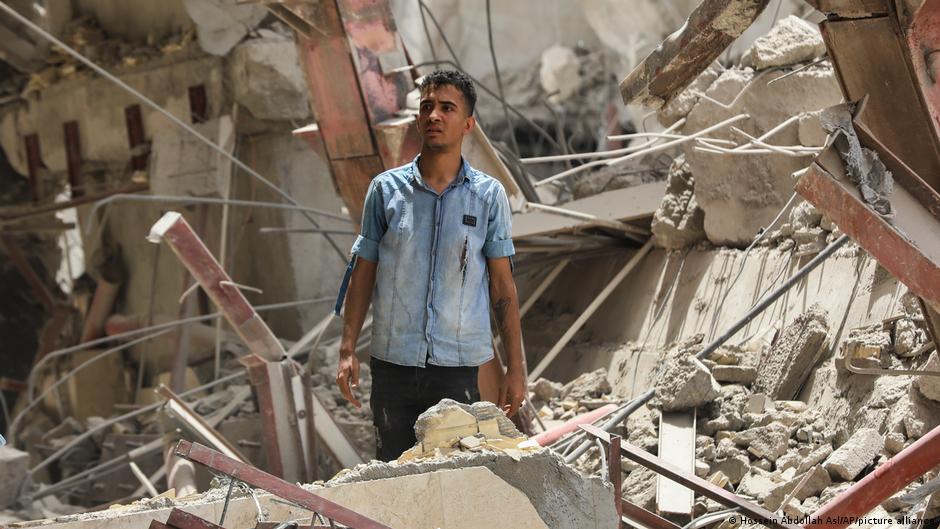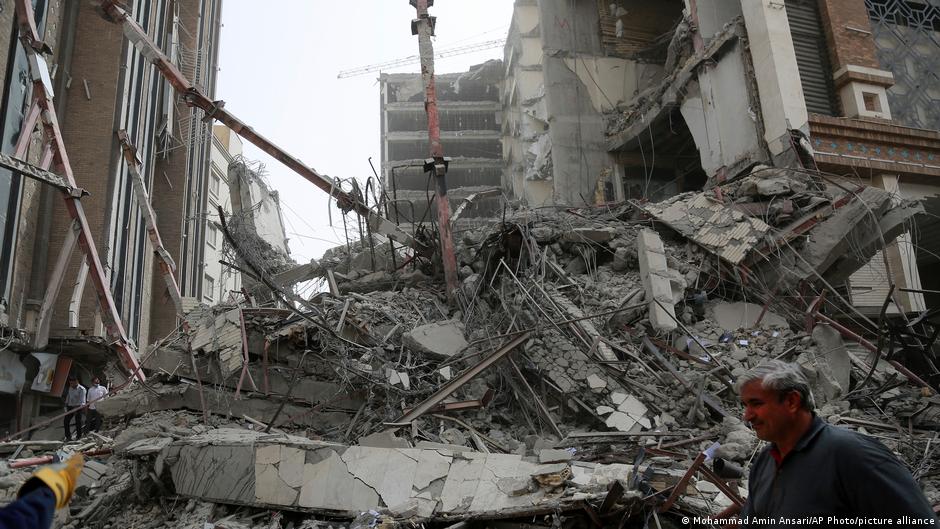Why the Abadan building collapse matters

On 23 May 2022, Metropol Tower, a 10-story commercial building in the city of Abadan in Iran’s oil-rich southwestern Khuzestan Province, collapsed, killing at least 41 people and trapping dozens more beneath the rubble, according to disputed official figures. Although the lower floors were open to the public, the building was still under construction. According to an unverified eyewitness account, some 150 construction workers were in the basement at the time of the collapse. The tragedy was eerily reminiscent of the January 2017 fire that engulfed the iconic Plasco building in Tehran, killing 26 people, among them firefighters.
Within an hour of the collapse of the tower, anti-riot police, true to their crisis-management playbook, flooded the region. In stark contrast, however, it took more than 24 hours for firefighters, emergency personnel and rescue workers to arrive from Tehran – and once they finally reached Abadan, they lacked the equipment necessary to conduct rescue operations. In the absence of a responsible and responsive government, ordinary citizens, equipped with nothing more than simple kitchen pots, worked day and night to pull survivors out from under the rubble.
For an outside observer, this might seem like a tragic, but random accident that could have happened anywhere. In reality, it is a stark illustration of a country mired in corruption and mismanagement. For the past four decades, the criminals responsible for such deadly tragedies have time and again escaped justice, thanks to their connections with the Islamic Republic’s ruling class. This time around, the culprits seem poise once again to wash their hands of the crimes they’ve committed.

Four decades of neglect
The collapse of buildings like the Metropol tower is the culmination of four decades of social, political and ecological neglect born of rampant institutionalised corruption. From its inception, the regime has relied on a distinction between "insiders" (khodi) and "outsiders" (qeyr-e khodi) to dole out access not only to political power but also to economic resources and privileges. The clique of "insiders" in the political arena have thus accumulated fabulous wealth.
When Ali Khamenei, the current supreme leader, took power in 1989, lacking the religious qualifications and popular credibility of his predecessor among regime "insiders", he reinforced efforts to translate the political "insider-outsider" binary into state and para-statal economic organisations. Even though state organisations were not accessible to regime "outsiders", they were nonetheless subject to rules and regulations.
The managers of these organisations sometimes switched from one government to the next, although no "outsider" is ever promoted to the highest ranks. Khamenei further institutionalised the insider-outsider distinction in state-regulated sectors of the economy, which are at least assumed to be responsible to the public, and para-statal economic organisations, which are exempt from taxes as well as general auditing. He also expanded existing para-statal organisations, known as bonyads, at an exponential rate.
Neither specialised researchers nor the general public know for certain the extent of para-statal organisations’ assets and activities, but these opaque entities clearly have a stranglehold on the Iranian economy. Chief among the bonyads is Astan Quds Razavi, a foundation that manages the shrine of Imam Reza in Mashhad and is considered the largest landowner in the Middle East, with six major holding companies and a total of 351 firms. The Martyr’s Foundation (Bonyad Shahid) controls more than 250 companies, and the Foundation for the Oppressed (Bonyad Mostazafan), the owner of the collapsed Plasco building, oversees more than 400 companies and subsidiaries across nearly every sector of Iranian industry.
The Imam Khomeini Relief Foundation (Comite Emdad Emam Khomeini), another leading player with its four holdings, is even less transparent. Last but not least, the Headquarters for Executing the Order of the Imam (Setad Ejra-ye Farman Emam) operates in most industrial and business sectors. Such bonyads abound and following the nationwide protests at the turn of the year 2017/18, both state and para-statal bonyads are run directly by the Supreme Leader and CEO Khamenei himself.
The people of #Abadan and the victims' families are still waiting for a public court to be held and demand an investigation to hold those accountable who caused the death of their loved ones. 2/2#IranProtests pic.twitter.com/caJflnBDLG
— NCRI-FAC (@iran_policy) July 1, 2022
The Revolutionary Guards' economic empire
In the same vein, the IRGC evolved from a defence force during the Iraq-Iran War into a far-flung empire, active not only on the battlefield but also in diverse markets.
In other words, a well-run quasi-state has grown not only in size but also in influence, transforming into perhaps the most powerful political force in contemporary Iran, with its own financial, economic, industrial, agricultural, military, cultural, and intelligence arms. Its Khatam al-Anbiya mega-conglomerate, for example, has come to monopolise major infrastructure projects in Iran.
Through this network, Khamenei funnels resources to the elite, bestows patronage and buys influence and political support. Members of the elite are shuffled between the various bonyads. Parviz Fattah, former head of the Imam Khomeini Relief Foundation, went on to become the head of the Foundation for the Oppressed. Mohammad Mokhber, former business and transportation deputy of the Foundation for the Oppressed, became the head of the Headquarters for Executing the Order of the Imam until recently, when he moved over to the vice presidency. Iran’s current president, Ebrahim Raisi, became the chairman of Astan Qods Razavi and then the chief justice before assuming the presidency. The list goes on.
Corruption and clientelism are ingrained in the political economy of the Islamic Republic. This labyrinthine system, inscrutable even to Iranians, coupled with the dominance of the IRGC over Iran’s economy, has resulted in systemic corruption in which proximity to the IRGC elite and allegiance to the supreme leader determine success.
Abdolbaghi’s holding company, for instance, was working directly with the Arvand Free Trade Zone Organisation, one of the main parties responsible for the Metropol disaster, as it issued the building permit. Its former board of directors included, among others, Ali Shamkhani, a former IRGC commander and now secretary-general of the Supreme National Security Council; Mohammad Forouzandeh, a former IRGC commander and the longest-serving head of the Foundation for the Oppressed; and Iranian Vice President Mokhber. During a visit to the site, Mokhber decried, without a hint of irony, the "widespread corruption" that led to the building’s collapse.
The Abadan municipality, itself a shareholder in the Metropol project, had sold land to the company at a steep discount in exchange for properties for the local authorities. Abdolbaghi also built a police station in Abadan in a blatant quid pro quo and was hailed by the chief of the Khuzestan police as a "philanthropist". Pictures show him with the former mayor and governor of Khuzestan Province, both of whom have been accused by locals of involvement in his construction projects.
Abdolbaghi himself is said to have been found dead in the rubble of the building, seemingly killed by the results of his own corruption. But there is little trust in any official statement these days, and the Abadan special prosecutor had previously stated that Abdolbaghi was arrested along with 10 others involved in the construction of the Metropol building, including current and former mayors. Ultimately, regardless of his fate, Abdolbaghi is just one cog in a much larger machine of corruption. Protestors in Abadan and other cities in Khuzestan are now making their voices heard, chanting a clear response to four decades of corruptocracy: "The mullahs must go".
Rahman Bouzari & Ali Fathollah-Nejad
